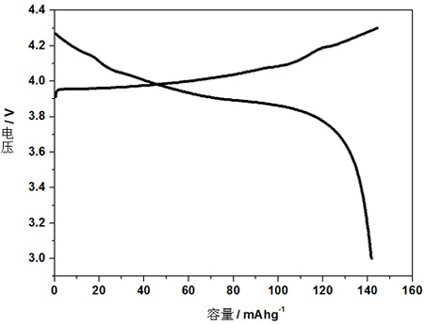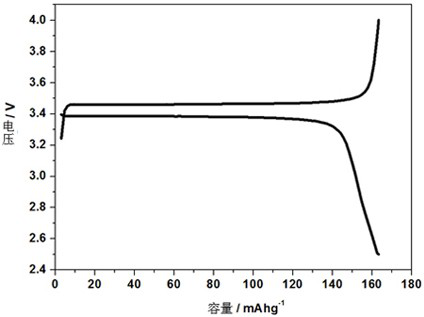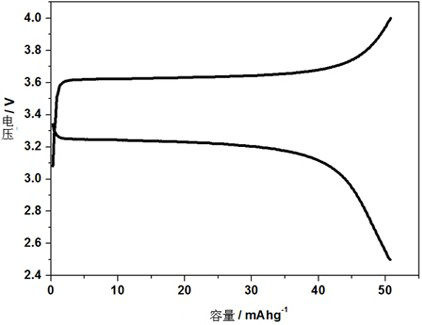A kind of high safety solid state electrolyte and its preparation method and application
A solid electrolyte, safe technology, applied in the direction of solid electrolyte, non-aqueous electrolyte, non-aqueous electrolyte battery, etc., can solve problems such as battery damage, achieve the effect of preventing deterioration, improving interface impedance, and preventing short circuit in the battery
- Summary
- Abstract
- Description
- Claims
- Application Information
AI Technical Summary
Problems solved by technology
Method used
Image
Examples
Embodiment 1
[0104] Under the condition of no water or oxygen, 2,3-Dihydroxypropyl acrylate, 1,6-hexandiisocyanate and lithium difluoroacetate borate were prepared into a homogeneous solution according to the mass ratio of 2:8:2. The solution was then assembled into LiCoO 2 / Li battery and place the battery in a thermostat at 80 ℃ for polymerization for 10 hours. The thermal decomposition temperature of the electrolyte is as high as 350 ℃, and there is no melting point. The assembled LiCoO 2 / The specific discharge capacity of Li button battery is 140 MAH / g at 60 ℃, 120 MAH / g at room temperature and 150 MAH / g at 120 ℃. The specific discharge capacity at 150 ℃ is reduced to 40 MAH / g, and the ionic conductivity of polymer electrolyte is one order of magnitude lower than that at 100 ℃.
Embodiment 2
[0106] Under the condition of no water or oxygen, 2,3-Dihydroxypropyl methacrylate, isoflurone diisocyanate and lithium trifluoromethylsulfonimide were prepared into a homogeneous solution according to the mass ratio of 2:8:5. The solution was then assembled into LiFePO 4 / Li battery and place the battery in a thermostat at 60 ℃ for polymerization for 12 hours. The assembly temperature of LiFePO is 350 ℃, and there is no thermal decomposition of LiFePO 4 / The specific discharge capacity of Li button battery is 150mah / g at 60 ℃, 130mah / g at room temperature and 160mah / g at 120 ℃. The specific discharge capacity at 150 ℃ is reduced to 50 MAH / g, and the ionic conductivity of polymer electrolyte is significantly lower than that at 100 ℃.
Embodiment 3
[0108] Under the condition of no water or oxygen, hydroxyethyl methacrylate, isoflurone diisocyanate and lithium trifluoromethylsulfonimide were prepared into a homogeneous solution according to the mass ratio of 2:8:2. The solution was then assembled into LiFePO 4 / Li battery and place the battery in a thermostat at 60 ℃ for polymerization for 10 hours. The thermal decomposition temperature of the electrolyte is as high as 350 ℃, and there is no melting point. LiFePO is assembled 4 / The specific discharge capacity of Li button battery is 140 MAH / g at 60 ℃, 120 MAH / g at room temperature and 150 MAH / g at 120 ℃. The specific discharge capacity at 150 ℃ is reduced to 50 MAH / g, and the ionic conductivity of polymer electrolyte is significantly lower than that at 100 ℃.
PUM
| Property | Measurement | Unit |
|---|---|---|
| melting point | aaaaa | aaaaa |
| thermal decomposition temperature | aaaaa | aaaaa |
| thermal decomposition temperature | aaaaa | aaaaa |
Abstract
Description
Claims
Application Information
 Login to View More
Login to View More - R&D
- Intellectual Property
- Life Sciences
- Materials
- Tech Scout
- Unparalleled Data Quality
- Higher Quality Content
- 60% Fewer Hallucinations
Browse by: Latest US Patents, China's latest patents, Technical Efficacy Thesaurus, Application Domain, Technology Topic, Popular Technical Reports.
© 2025 PatSnap. All rights reserved.Legal|Privacy policy|Modern Slavery Act Transparency Statement|Sitemap|About US| Contact US: help@patsnap.com



